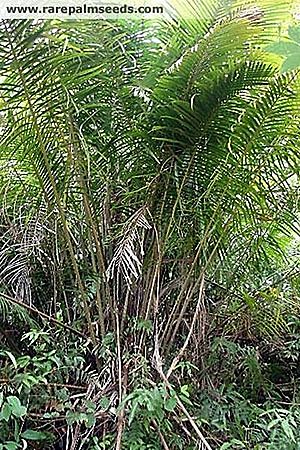Eugeissona tristis
| Eugeissona (yoo-gee-SOHN-ah) tristis (TREES-tiss) | |||||||
|---|---|---|---|---|---|---|---|
 Jemaluang, Johor, Malaysia. Photo by Dr. John Dransfield, Royal Botanic Gardens, Kew/Palmweb. | |||||||
| Scientific Classification | |||||||
| |||||||
| Synonyms | |||||||
|
| |||||||
| Native Continent | |||||||
|
| |||||||
| Morphology | |||||||
| |||||||
| Culture | |||||||
|
| |||||||
| Survivability index | |||||||
|
| |||||||
| Common names | |||||||
|
| |||||||
Contents
Habitat and Distribution
South Peninsular Thailand to Peninsular Malaysia. Lowland and hill forest up to elevations of about 700 metres.Description
Fiercely spiny acaulescent palm forming dense thickets of up to 12 individual stems in the forest undergrowth. Leaves 7–10 per mature shoot, up to 8 m long; petiole up to 3 m long, up to 5 cm in diam. at the tip of the ligule, densely covered with irregularly arranged shiny black spines to 5 cm long, decreasing in size towards the petiole tip; rachis armed as the petiole; leaflets to 100 or more on each side of the rachis, regularly arranged, with abundant black bristles along the midrib, the longest leaflets to 90 cm long, 2–4 cm wide. Inflorescence system terminal, shorter than the leaves, to 5 m tall, subtending leaves of lateral inflorescences gradually decreasing to bracts; ultimate branches terminating in cupules of 12–13 tightly imbricate brown striate unarmed bracts, enclosing a pair of flowers comprising a male and a hermaphroditic flower, the males of the inflorescence emerging first, followed by the hermaphroditic. Male flowers borne on a short pedicel to 1 cm long, to 6 cm long, shiny brown; calyx to 2 cm, striate; petals to 6 cm, tubular at the base, distally split into 3 spine tipped woody petals; stamens 22–27, anthers elongate, dangling at anthesis. Hermaphroditic flower similar to the male flower, but with an asymmetrically flattened tip in bud; gynoecium ovoid, tipped with conspicuous pyramidal stigma. Fruit at maturity 7–9 x 3–5 cm, beaked; epicarp scales brown, somewhat irregularly arranged; endocarp with 3 + 3 flanges penetrating the homogeneous endosperm. Editing by edric.
Culture
Cold Hardiness Zone: 11
Comments and Curiosities
It is harvested from the wild for local use as a food, and source of materials for building, weaving etc. The immature fruit is edible. The midribs of the leaves are made into matting and used to make inner and outer walls of houses. The leaves are used for thatch.
Large, ascending leaves to about 6 m (20 ft.) tall, with glossy green leaflets, spiny leafstalks and a mostly underground, clustering trunk characterize this unusual palm from the Malay Peninsula. It is found in disturbed, open areas in rainforests between sea level and 800 m (2700 ft.). The large, scaly fruit are edible when unripe and the leaves make excellent thatch. Rarely seen in cultivation, it does best in tropical areas and appreciates sun and plenty of water to look its best. (RPS.com)
- IMAGE GALLERY
External Links
- Glossary of Palm Terms
- MODERN BOTANICAL LATIN
- "Just To Be Clear"
- Biomass and Carbon Estimation of Eugeissona tristis
References
Phonetic spelling of Latin names by edric.
Special thanks to Geoff Stein, (Palmbob) for his hundreds of photos.
Special thanks to Palmweb.org, Dr. John Dransfield, Dr. Bill Baker & team, for their volumes of information and photos.
Glossary of Palm Terms; Based on the glossary in Dransfield, J., N.W. Uhl, C.B. Asmussen-Lange, W.J. Baker, M.M. Harley & C.E. Lewis. 2008. Genera Palmarum - Evolution and Classification of the Palms. Royal Botanic Gardens, Kew. All images copyright of the artists and photographers (see images for credits).
Many Special Thanks to Ed Vaile for his long hours of tireless editing and numerous contributions.













































